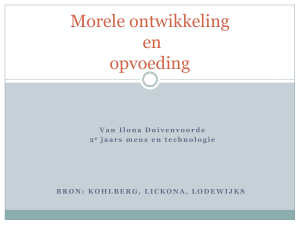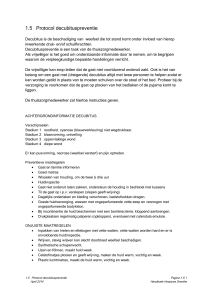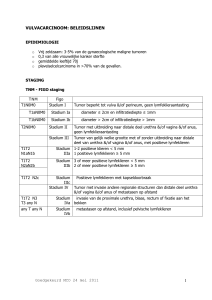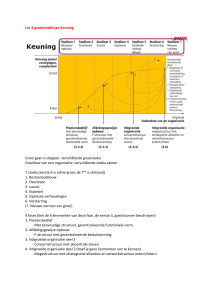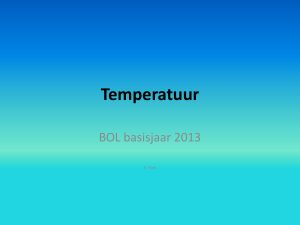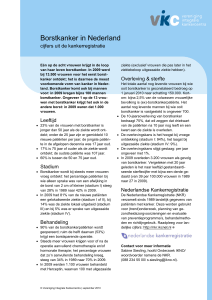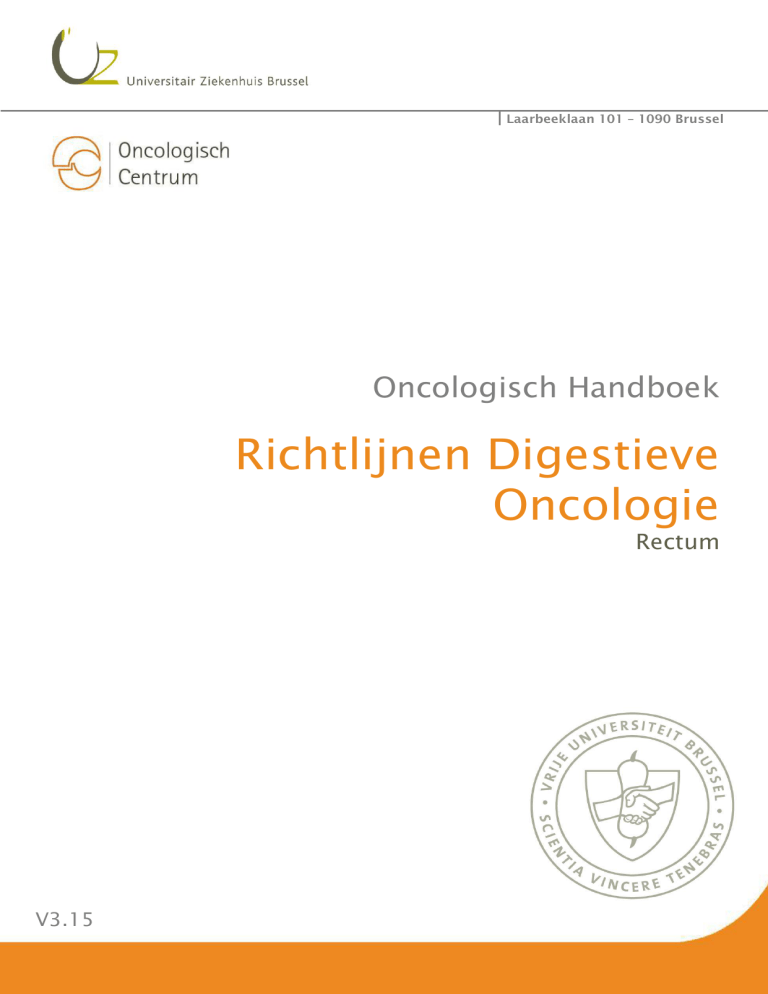
Laarbeeklaan 101 – 1090 Brussel
Oncologisch Handboek
Richtlijnen Digestieve
Oncologie
Rectum
V3.15
Oncologisch Handboek
UZ Brussel
RECTUM – ICD-O C20
1. Classificatie (UICC TNM Classification of Malignant
Tumors; Seventh edition)
Tx
T0
Tis
T1
T2
T3
=
=
=
=
=
=
oordeel over primaire tumor niet mogelijk
geen primaire tumor
carcinoma in situ: intra-epitheliaal of invasie van de lamina propria
invasie van de submucosa
invasie van de muscularis propria
invasie van de subserosa of in niet-geperitonealiseerd pericolisch of perirectaal
weefsel
T4 = perforatie van het viscerale peritoneum en/of directe invasie in andere organen of
structuren
T4a = perforatie van het viscerale peritoneum
T4b = directe invasie in andere organen of structuren
Nx = oordeel over regionale lymfeklieren niet mogelijk
N0 = geen regionale lymfekliermetastasen
N1 = metastase in 1-3 regionale lymfeklieren
N1a = metastase in 1 regionale lymfeklier
N1b = metastase in 2-3 regionale lymfeklieren
N1c = tumor deposit(s), satellites, in de subserosa, of in niet-geperitonealiseerde
pericolische of perirectale weefsels zonder regionale kliermetastasen
N2 = metastase in 4 of meer regionale lymfeklieren
N2a = metastase in 4-6 regionale lymfeklieren
N2b = metastase in 7 of meer regionale lymfeklieren
M0 = geen metastasen op afstand
M1 = metastase(n) op afstand
M1a = metastase beperkt tot 1 orgaan (lever, long, ovarium, niet-regionale
lymfeklier(en))
M1b = metastase in meer dan 1 orgaan of in het peritoneum
*
Voor elke lokalisatie en sublokalisatie zijn de regionale lymfeklieren de volgende:
Caecum
ileocolic, right colic
Colon ascendens
ileocolic, right colic, middle colic
Flexura hepatica
middle colic, right colic
Colon transversum right colic, middle colic, left colic, inferior mesenteric
Flexura lienalis
middle colic, left colic, inferior mesenteric
Colon descendens left colic, inferior mesenteric
Colon sigmoideum sigmoid, left colic, superior rectal (haemorrhoidal),
inferior mesenteric and rectosigmoid
** pN: standaard dienen in het resectie specimen minimum 12 regionale lymfeklieren
onderzocht te worden om een adequate staging te hebben. Indien er minder werden
onderzocht, doch allen zijn negatief, wordt toch pN0 gebruikt.
Richtlijnen Digestieve Oncologie
Rectum
-2-
Oncologisch Handboek
UZ Brussel
Stadium indeling:
Stadium
Stadium
Stadium
Stadium
Stadium
Stadium
Stadium
Stadium
0:
I:
II:
IIA:
IIB:
IIC:
III:
IIIA:
Stadium IIIB:
Stadium IIIC:
Stadium IVA:
Stadium IVB:
Tis
T1-2
T3-4
T3
T4a
T4b
elke T
T1-2
T1
T3-4a
T2-3
T1-2
T4a
T3-4a
T4b
elke T
elke T
N0
N0
N0
N0
N0
N0
N1-2
N1
N2a
N1
N2a
N2b
N2a
N2b
N1-2
elke N
elke N
Richtlijnen Digestieve Oncologie
M0
M0
M0
M0
M0
M0
M0
M0
M0
M0
M0
M0
M0
M0
M0
M1a
M1b
Rectum
-3-
Oncologisch Handboek
UZ Brussel
2. Staging
-
-
Anamnese, inclusief risicofactoren
Klinisch Onderzoek, inclusief lengte en gewicht
Evaluatie nutritionele toestand
o NRS (nutritional risk score)
o BMI
Indien één van beiden afwijkend: consultatie Diëtiek of Nutritieteam, naargelang de
ernst van de anamnese.
Geriatrisch assessment bij patiënten vanaf 70 jaar of op indicatie
Totale colonoscopie met biopten.
Indien niet mogelijk wegens obstruerende tumor dient een totale colonoscopie perof post-operatief gepland te worden.
CT thorax-abdomen
Labo, inclusief CEA
In pre-operatieve setting: Barium-lavement
Inventarisatie van comorbiditeiten en medicatie
Bepalen Karnofsky-score
3. Behandeling
De therapie voor het rectumcarcinoom wordt beslist op basis van de cTNM-classificatie.
1.1 STADIUM 0-I (CTIS-1-2)
Rectumtumoren stadium I worden behandeld dmv. primaire heelkunde. Geen neo-adjuvante
behandeling.
1.2 STADIUM II-III (CT3-4)
Neo-adjuvante behandeling
Bij T3-T4 tumoren wordt een neo-adjuvante behandeling voorzien ovv.:
- Radiotherapie (23 x 2 Gy) met concomitante boost op de tumor tot een cumulatieve
dosis van 55,2 Gy
of
- Radiochemotherapie (23 x 2 Gy + Xeloda)
Heelkunde
Na de neo-adjuvante therapie wordt een heelkunde resectie van de primaire tumor
uitgevoerd.
Adjuvante behandeling
Indicatie tot adjuvante chemotherapie
Enkel indien de patiënt neo-adjuvant Xeloda kreeg, mét respons (cT3-4 => ypT0-2 of Dworak
2-4), en indien er geen majeure toxiciteit is opgetreden, zal adjuvant Xeloda worden
toegediend gedurende 6 maanden.
Richtlijnen Digestieve Oncologie
Rectum
-4-
Oncologisch Handboek
UZ Brussel
Indien ypTN+: Folfox gedurende 6 maanden.1
-
-
Indicatie tot post-operatieve radiotherapie
in principe wordt de behandeling met radiotherapie pre-operatief toegediend.
In uitzonderlijke gevallen kan post-operatieve radiotherapie worden overwogen:
o Indien de patiënt geen pre-operatieve radiotherapie kreeg en indien
onverwachte R1-resectie
Steeds te bespreken op het Multidisciplinair Oncologisch Consult om
te bepalen of dit een indicatie vormt voor post-operatieve
radiotherapie
Indien de patiënt pre-operatieve radiotherapie weigerde, zal ook geen post-operatieve
radiotherapie worden opgestart.
1.3 STADIUM IV
Het stadium IV rectumcarcinoom wordt behandeld zoals de stadium IV coloncarcinomen.
Voor alle stadium IV rectumtumoren wordt een KRAS/NRAS-bepaling uitgevoerd.
Er wordt voor de behandeling een onderverdeling gemaakt tussen reseceerbare metastasen
bij diagnose, potentieel reseceerbare en niet-reseceerbare metastase(n).
Reseceerbeer leverletsel, solitaire klier/longM+ bij diagnose
Indien aanwezigheid van een reseceerbaar leverletsel, een solitaire klier of solitaire
longmetastasen: indicatie voor heelkundige resectie (colontumor + metastase).
Na heelkunde volgt een adjuvante behandeling: 6 maanden Folfox
Simultaan primaire tumor en potentieel reseceerbare levermetastase
Met potentieel reseceerbare metastase wordt bedoeld: een metastase die mogelijks
reseceerbaar is na systemische behandeling.
Voor patiënten met simultaan een primaire tumor en een potentieel reseceerbare
levermetastase, wordt eerst heelkunde van het colon uitgevoerd, gevolgd door systemische
behandeling (zie onderstaande tabel).
RASwt
RASmut
Systemische behandeling bij potentieel reseceerbare metastase(n)
Folfiri + cetuximab
Folfiri + bevacizumab
(bevacizumab stoppen 4 tot 6 weken voor heelkunde)
Op het ogenblik van de beste respons op de systemische behandeling (meestal na ongeveer
4 cycli/4 maanden), volgt een herbespreking van de mogelijke opties op het Multidisciplinair
Oncologisch Consult:
- Heelkunde levermetastase
- RFA
- SBRT
- Verdere systemisch behandeling
1
ADORE trial, Hong et al. Lancet Oncology 2014
Richtlijnen Digestieve Oncologie
Rectum
-5-
Oncologisch Handboek
UZ Brussel
Niet reseceerbare metastase(n) (diffuus gemetastaseerd)
Bij niet-reseceerbare metastase(n) wordt een systemische behandeling opgestart in functie
van de RKAS/NRAS status (zie onderstaande tabel).
RASwt
RASmut
Systemische behandeling bij niet-reseceerbare metastase(n)
1e lijn
Folfiri + bevacizumab
2e lijn
Folfox + cetuximab
1e lijn
Folfiri + bevacizumab
2e lijn
Folfox + bevacizumab
Richtlijnen Digestieve Oncologie
Rectum
-6-
Oncologisch Handboek
UZ Brussel
4. Opvolging na curatieve behandeling
Gedurende het 1e jaar:
- Op 3 maanden: klinische opvolging + CEA
- Op 6 maanden: CT thorax-abdomen, CEA indien gestegen CEA vóór de ingreep
- Op 9 maanden: klinische opvolging + CEA
- Na 1 jaar: colonoscopie, CEA, CT thorax-abdomen.
Indien stijging CEA: PET CT.
Gedurende het 2e jaar:
o Om de 6 maanden: CT thorax-abdomen + CEA
Gedurende het 3e-5e jaar:
- Om de 6 maanden: klinische opvolging, CEA, CT thorax-abdomen
- Colonoscopie: afhankelijk van het resultaat van de colonoscopie op 1 jaar wordt
opnieuw een colonoscopie uitgevoerd na 2-3 jaar of na 3-4 jaar.
De opvolging van de patiënt gebeurt zowel op de consultatie Oncologische Heelkunde als op
de consultatie Medische Oncologie.
5. Familiaal colorectaal carcinoom
Definitie: colorectaal carcinoom bij meerdere eerste- en/of tweedegraadsverwanten op
relatief jonge leeftijd.
Patiënten met een familiale geschiedenis en/of polypose worden verwezen naar de kliniek
voor Familiale Kanker van het OC voor counseling, eventueel genetische testing en het
uitwerken van voorstellen voor kankerpreventie in de betrokken proband en de rest van de
familie.
Richtlijnen Digestieve Oncologie
Rectum
-7-
Oncologisch Handboek
UZ Brussel
BIJLAGEN
Bijlage 1
Titel:
Oxaliplatin, fluorouracil, and leucovorin versus fluorouracil and leucovorin as adjuvant
chemotherapy for locally advanced rectal cancer after preoperative chemoradiotherapy
(ADORE): an open-label, multicentre, phase 2, randomised controlled trial.
Hong YS1, Nam BH2, Kim KP1, Kim JE1, Park SJ1, Park YS3, Park JO3, Kim SY4, Kim TY5, Kim
JH6, Ahn JB7, Lim SB8, Yu CS8, Kim JC8, Yun SH9, Kim JH10, Park JH10, Park HC11, Jung
KH1, Kim TW12.
Lancet Oncol. 2014 Oct;15(11):1245-53.
Abstract:
BACKGROUND:
The role of adjuvant chemotherapy for patients with rectal cancer is controversial, especially
when used after preoperative chemoradiotherapy. Fluoropyrimidine-based adjuvant
chemotherapy, including fluorouracil and leucovorin, has been widely used; however, the
addition of oxaliplatin to fluorouracil and leucovorin (FOLFOX), a standard adjuvant regimen
for colon cancer, has not been tested in rectal cancer. We aimed to compare the efficacy and
safety of adjuvant fluorouracil and leucovorin with that of FOLFOX in patients with locally
advanced rectal cancer after preoperative chemoradiotherapy.
METHODS:
In this open-label, multicentre, phase 2, randomised trial, patients with postoperative
pathological stage II (ypT3-4N0) or III (ypTanyN1-2) rectal cancer after preoperative
fluoropyrimidine-based chemoradiotherapy and total mesorectal excision were recruited and
randomly assigned (1:1) via a web-based software platform to receive adjuvant
chemotherapy with either four cycles of fluorouracil and leucovorin (fluorouracil 380
mg/m(2) and leucovorin 20 mg/m(2) on days 1-5, every 4 weeks) or eight cycles of FOLFOX
(oxaliplatin 85 mg/m(2), leucovorin 200 mg/m(2), and fluorouracil bolus 400 mg/m(2) on
day 1, and fluorouracil infusion 2400 mg/m(2) for 46 h, every 2 weeks). Stratification factors
were pathological stage (II vs III) and centre. Neither patients nor investigators were masked
to group assignment. The primary endpoint was 3-year disease-free survival, analysed by
intention to treat. This study is fully enrolled, is in long-term follow-up, and is registered
with ClinicalTrials.gov, number NCT00807911.
FINDINGS:
Between Nov 19, 2008, and June 12, 2012, 321 patients were randomly assigned to
fluorouracil and leucovorin (n=161) and FOLFOX (n=160). 141 (95%) of 149 patients in the
fluorouracil plus leucovorin group and 141 (97%) of 146 in the FOLFOX group completed all
planned cycles of adjuvant treatment. Median follow-up was 38·2 months (IQR 26·4-50·6). 3year disease-free survival was 71·6% (95% CI 64·6-78·6) in the FOLFOX group and 62·9%
(55·4-70·4) in the fluorouracil plus leucovorin group (hazard ratio 0·657, 95% CI 0·4340·994; p=0·047). Any grade neutropenia, thrombocytopenia, fatigue, nausea, and sensory
neuropathy were significantly more common in the FOLFOX group than in the fluorouracil
plus leucovorin group; however, we noted no significant difference in the frequency of these
Richtlijnen Digestieve Oncologie
Rectum
-8-
Oncologisch Handboek
UZ Brussel
events at grade 3 or 4. The most common grade 3 or worse adverse events were neutropenia
(38 [26%] of 149 patients in the fluorouracil plus leucovorin group vs 52 [36%] of 146
patients in the FOLFOX group), leucopenia (eight [5%] vs 12 [8%]), febrile neutropenia (four
[3%] vs one [<1%]), diarrhoea (four [3%] vs two [1%]), and nausea (one [<1%] vs two [1%]).
INTERPRETATION:
Adjuvant FOLFOX improves disease-free survival compared with fluorouracil plus leucovorin
in patients with locally advanced rectal cancer after preoperative chemoradiotherapy and
total mesorectal excision, and warrants further investigation.
FUNDING:
Korea Healthcare Technology R&D Project (South Korean Ministry of Health and Welfare).
Richtlijnen Digestieve Oncologie
Rectum
-9-


